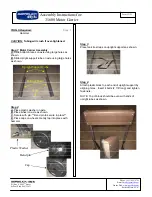
http://www.tyan.com
68
standard set of preboot protocol services within a client with the goal of allowing
networked-based booting to boot using industry standard protocols.
RAID (Redundant Array of Independent Disks):
a way for the same data to be stored in
different places on many hard drives. By using this method, the data is stored redundantly
and multiple hard drives will appear as a single drive to the operating system. RAID level
0 is known as striping, where data is striped (or overlapped) across multiple hard drives,
but offers no fault-tolerance. RAID level 1 is known as mirroring, which stores the data
within at least two hard drives, but does not stripe. RAID level 1 also allows for faster
access time and fault-tolerance, since either hard drive can be read at the same time.
RAID level 0+1 is both striping and mirroring, providing fault-tolerance, striping, and faster
access all at the same time.
RAIDIOS:
RAID I/O Steering (Intel)
RAM (Random Access Memory):
technically refers to a type of memory where any byte
can be accessed without touching the adjacent data and is often referred to the system’s
main memory. This memory is available to any program running on the computer.
ROM (Read-Only Memory):
a storage chip which contains the BIOS; the basic
instructions required to boot the computer and start up the operating system.
SDRAM (Synchronous Dynamic RAM):
called as such because it can keep two sets of
memory addresses open simultaneously. By transferring data alternately from one set of
addresses and then the other, SDRAM cuts down on the delays associated with non-
synchronous RAM, which must close one address bank before opening the next.
Serial port:
called as such because it transmits the eight bits of a byte of data along one
wire, and receives data on another single wire (that is, the data is transmitted in serial
form, one bit after another).
SCSI Interrupt Steering Logic (SISL):
Architecture that allows a RAID controller, such
as AcceleRAID 150, 200 or 250, to implement RAID on a system board-embedded SCSI
bus or a set of SCSI busses. SISL: SCSI Interrupt Steering Logic ( LSI ) (only on LSI
SCSI boards)
Sleep/Suspend mode:
in this mode, all devices except the CPU shut down.
SDRAM (Static RAM):
unlike DRAM, this type of RAM does not need to be refreshed in
order to prevent data loss. Thus, it is faster and more expensive.
Standby mode:
in this mode, the video and hard drives shut down; all other devices
continue to operate normally.
UltraDMA-33/66/100:
a fast version of the old DMA channel. UltraDMA is also called
UltraATA. Without a proper UltraDMA controller, your system cannot take advantage of
higher data transfer rates of the new UltraDMA/UltraATA hard drives.
USB (Universal Serial Bus):
a versatile port. This one port type can function as a serial,
parallel, mouse, keyboard or joystick port. It is fast enough to support video transfer, and
is capable of supporting up to 127 daisy-chained peripheral devices.
VGA (Video Graphics Array):
the PC video display standard
V-SYNC:
controls the vertical scanning properties of the monitor.



































